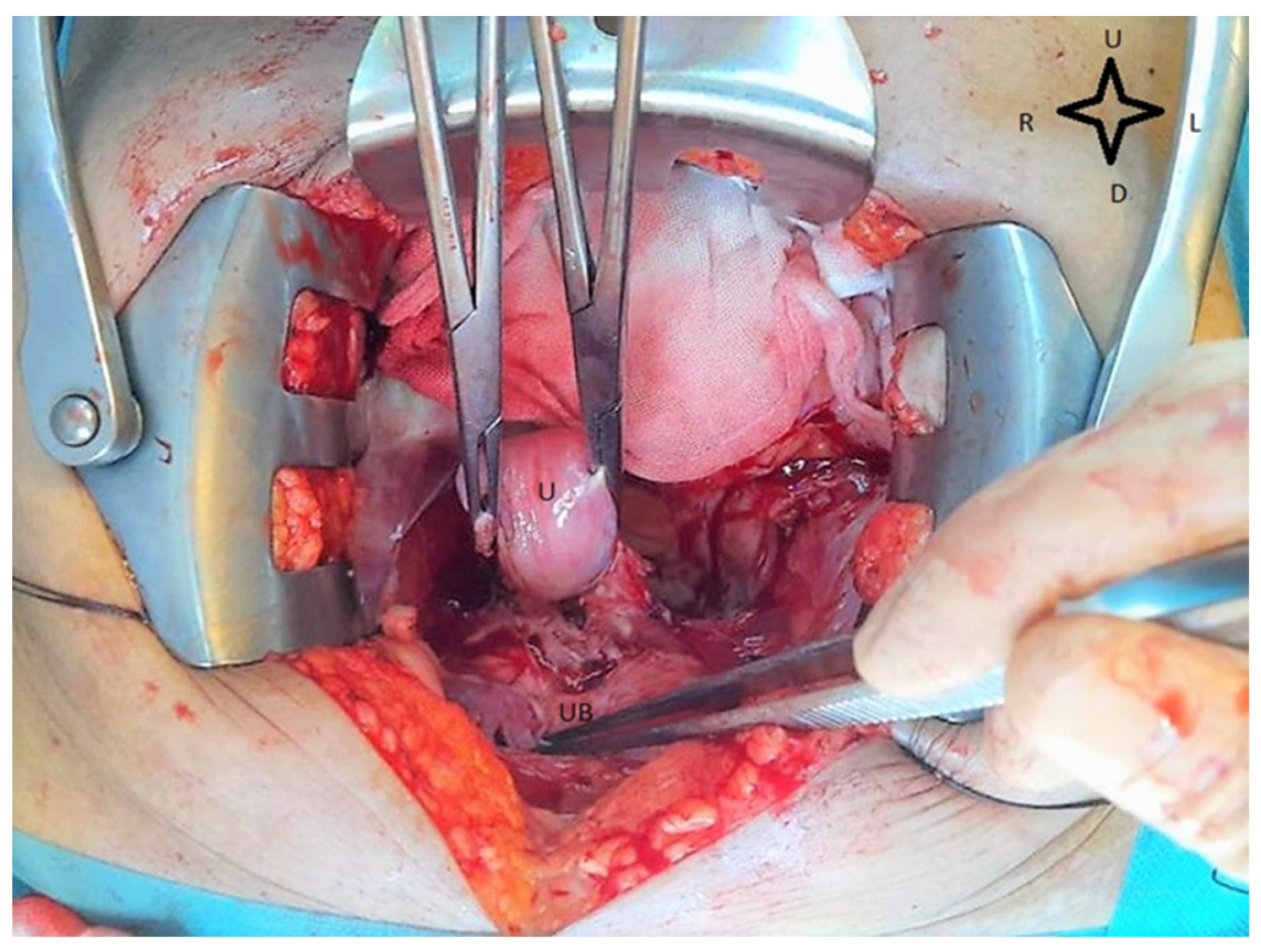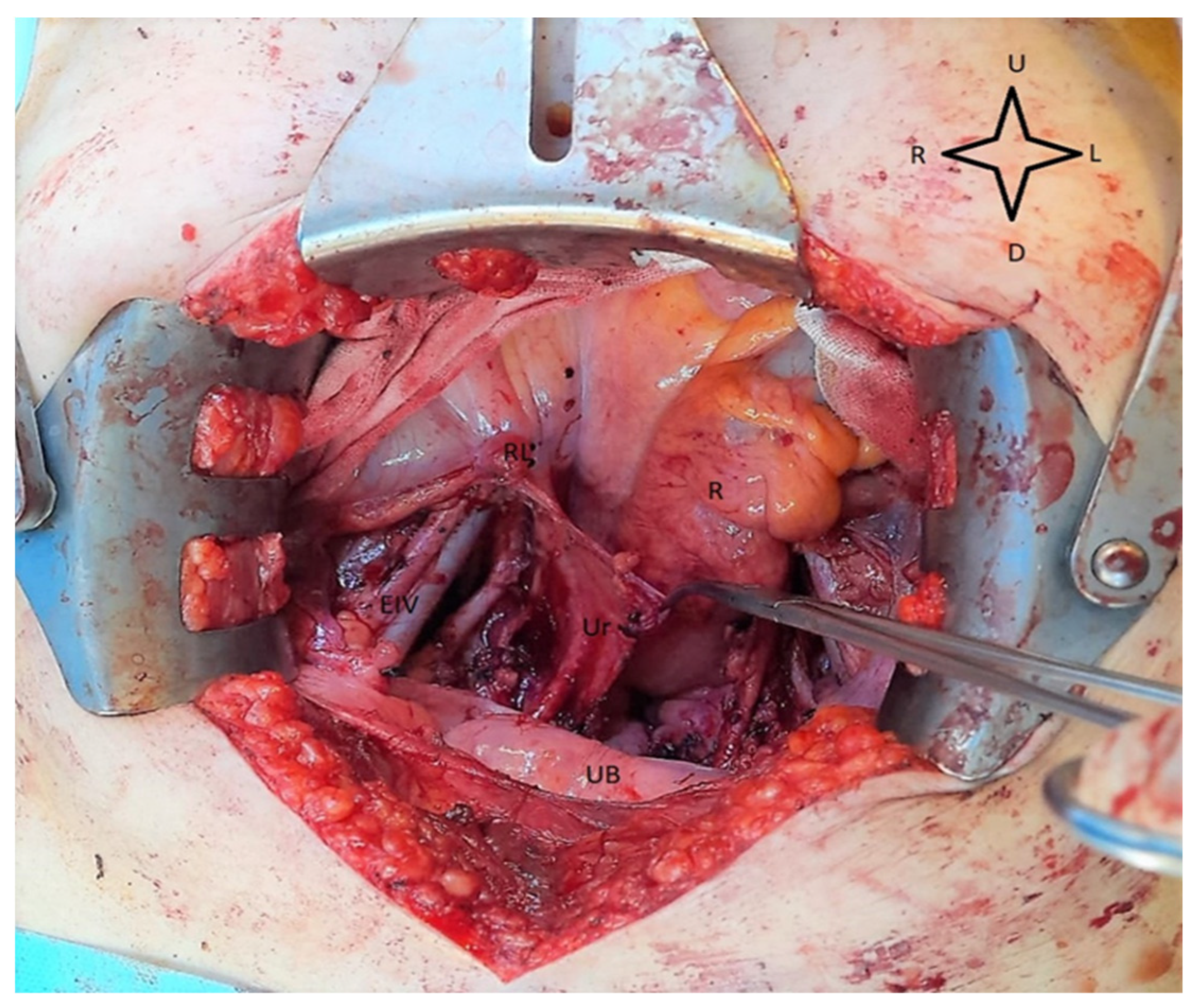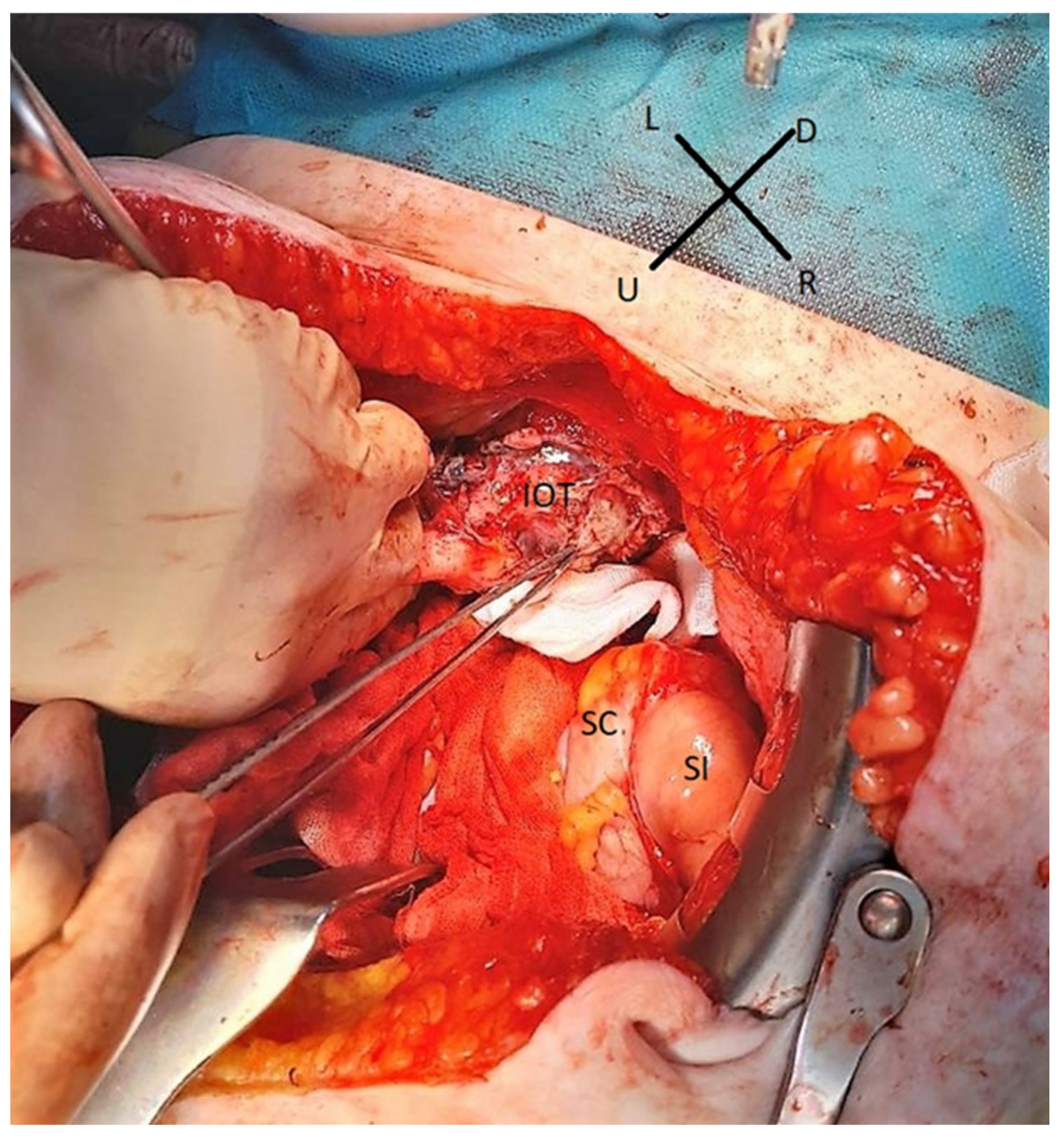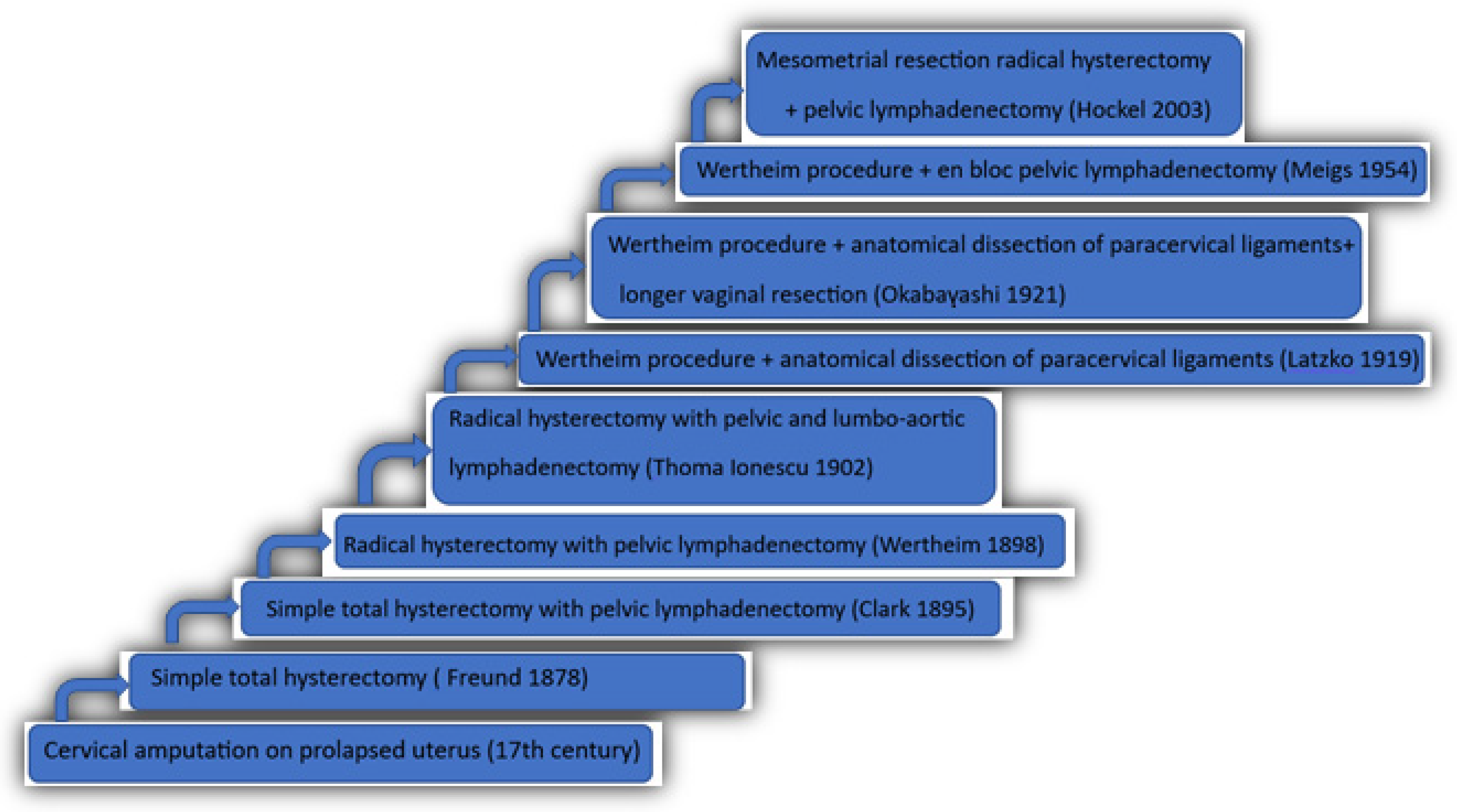Current Therapeutic Approaches in Cervical Cancer Based on the Stage of the Disease: Is There Room for Improvement?
Abstract
1. Introduction
2. Cervical Cancer Screening
3. History of the Treatment for Cervical Neoplasia
4. Multimodal Treatment of Cervical Cancer According to Disease Stage
4.1. Stage IA1
4.2. Stage IA2
4.3. Stages IB1, IB2, IIA1
4.4. Stages IB3 and IIA2
4.5. Stage IIB
4.6. Stage III
4.7. Stage IV
5. Future Improvement Strategies in Cervical Cancer Treatment
6. Conclusions
Author Contributions
Funding
Institutional Review Board Statement
Informed Consent Statement
Data Availability Statement
Conflicts of Interest
References
- Sung, H.; Ferlay, J.; Siegel, R.L.; Laversanne, M.; Soerjomataram, I.; Jemal, A.; Bray, F. Global Cancer Statistics 2020: GLOBOCAN Estimates of Incidence and Mortality Worldwide for 36 Cancers in 185 Countries. CA Cancer J. Clin. 2021, 71, 209–249. [Google Scholar] [CrossRef]
- Waggoner, S.E. Cervical cancer. Lancet 2003, 361, 2217–2225. [Google Scholar] [CrossRef] [PubMed]
- Rob, L.; Skapa, P.; Robova, H. Fertility-sparing surgery in patients with cervical cancer. Lancet Oncol. 2011, 12, 192–200. [Google Scholar] [CrossRef]
- Crosbie, E.J.; Einstein, M.H.; Franceschi, S.; Kitchener, H.C. Human papillomavirus and cervical cancer. Lancet 2013, 382, 889–899. [Google Scholar] [CrossRef] [PubMed]
- Roura, E.; Castellsagué, X.; Pawlita, M.; Travier, N.; Waterboer, T.; Margall, N.; Bosch, F.X.; de Sanjosé, S.; Dillner, J.; Gram, I.T.; et al. Smoking as a major risk factor for cervical cancer and pre-cancer: Results from the EPIC cohort. Int. J. Cancer 2014, 135, 453–466. [Google Scholar] [CrossRef]
- Kim, J.Y.; Lee, D.W.; Kim, M.J.; Shin, J.E.; Shin, Y.J.; Lee, H.N. Secondhand smoke exposure, diabetes, and high BMI are risk factors for uterine cervical cancer: A cross-sectional study from the Korea national health and nutrition examination survey (2010–2018). BMC Cancer 2021, 21, 880. [Google Scholar] [CrossRef] [PubMed]
- Jiang, J.; Pang, H.; Liu, B.; Nasca, P.C.; Zhang, B.; Wu, Y.; Han, W.; Gates, M.; Lu, T.; Zou, X.; et al. Effects of active, passive, and combined smoking on cervical cancer mortality: A nationwide proportional mortality study in Chinese urban women. Cancer Causes Control. 2015, 26, 983–991. [Google Scholar] [CrossRef]
- Maruthur, N.M.; Bolen, S.D.; Brancati, F.L.; Clark, J.M. The Association of Obesity and Cervical Cancer Screening: A Systematic Review and Meta-analysis. Obesity 2009, 17, 375–381. [Google Scholar] [CrossRef] [PubMed]
- Poorolajal, J.; Jenabi, E. The association between BMI and cervical cancer risk. Eur. J. Cancer Prev. 2016, 25, 232–238. [Google Scholar] [CrossRef]
- Ghosh, C.; Baker, J.A.; Moysich, K.B.; Rivera, R.; Brasure, J.R.; McCann, S.E. Dietary Intakes of Selected Nutrients and Food Groups and Risk of Cervical Cancer. Nutr. Cancer 2008, 60, 331–341. [Google Scholar] [CrossRef]
- Hoover, R.N.; Hyer, M.; Pfeiffer, R.M.; Adam, E.; Bond, B.; Cheville, A.L.; Colton, T.; Hartge, P.; Hatch, E.E.; Herbst, A.L.; et al. Adverse Health Outcomes in Women Exposed In Utero to Diethylstilbestrol. N. Engl. J. Med. 2011, 365, 1304–1314. [Google Scholar] [CrossRef]
- Schiffman, M.; Wentzensen, N.; Wacholder, S.; Kinney, W.; Gage, J.C.; Castle, P.E. Human Papillomavirus Testing in the Prevention of Cervical Cancer. JNCI J. Natl. Cancer Inst. 2011, 103, 368–383. [Google Scholar] [CrossRef] [PubMed]
- Eun, T.J.; Perkins, R.B. Screening for Cervical Cancer. Med. Clin. N. Am. 2020, 104, 1063–1078. [Google Scholar] [CrossRef]
- Fujii, S.; Sekiyama, K. Brief History of Surgical Treatment for Cervical Cancer. In Precise Neurovascular Anatomy for Radical Hysterectomy; Springer: Singapore, 2020; pp. 1–10. [Google Scholar] [CrossRef]
- Clark, J.G. A More Radical Method of Performing Hysterectomy for Cancer of the Uterus; The Johns Hopkins University Press: Baltimore, MD, USA, 1895. [Google Scholar]
- Wertheim, E. Die Erweiterte Abdominale Operation bei Carcinoma Colli Uteri (auf Grund von 500 Fallen); Urban Und Schwarzenberg: Berlin, Germany, 1911. [Google Scholar]
- Ionescu, T. Le Traitement Chirurgical du Cancer Utérin; International Congress of Surgery and Gynecology: Paris, France, 1902. [Google Scholar]
- Latzko, W.; Schiffmann, W.J. Klinisches und Anatomisches zur Radikaloperation des Gebärmutterkrebses. Zbl. Gynakol. 1919, 34, 689–705. [Google Scholar]
- Okabayashi, H. Radical abdominal hysterectomy for cancer of the cervix uteri, modification of the Takayama operation. Surg. Gynecol. Obstet. 1921, 33, 335–341. [Google Scholar]
- Meigs, J.V. Surgical Treatment of Cancer of the Cervix; Grune & Stration: New York, NY, USA, 1954. [Google Scholar]
- Höckel, M.; Horn, L.C.; Hentschel, B.; Höckel, S.; Naumann, G. Total mesometrial resection: High resolution nerve-sparing radical hysterectomy based on developmentally defined surgical anatomy. Int. J. Gynecol. Cancer 2003, 13, 791–803. [Google Scholar] [CrossRef] [PubMed]
- Pálfalvi, L.; Ungár, L. Laterally extended parametrectomy (LEP), the technique for radical pelvic side wall dissection: Feasibility, technique and results. Int. J. Gynecol. Cancer 2003, 13, 914–917. [Google Scholar] [CrossRef]
- Hellman, K.; Hellström, A.; Pettersson, B.F. Uterine cervix cancer treatment at Radiumhemmet: 90 years’ experience. Time trends of age, stage, and histopathology distribution. Cancer Med. 2014, 3, 284–292. [Google Scholar] [CrossRef]
- Zhou, J.; Wu, S.-G.; Sun, J.-Y.; Tang, L.-Y.; Lin, H.-X.; Li, F.-Y.; Chen, Q.-H.; Jin, X.; He, Z.-Y. Clinicopathological features of small cell carcinoma of the uterine cervix in the surveillance, epidemiology, and end results database. Oncotarget 2017, 8, 40425–40433. [Google Scholar] [CrossRef]
- NCCN Guidelines for Cervical Cancer n.d. Available online: https://www.nccn.org/professionals/physician_gls/pdf/cervical.pdf (accessed on 18 June 2023).
- Kim, S.I.; Choi, B.R.; Kim, H.S.; Chung, H.H.; Kim, J.-W.; Park, N.H.; Song, Y.-S.; Choi, C.H.; Lee, M. Cervical conization before primary radical hysterectomy has a protective effect on disease recurrence in early cervical cancer: A two-center matched cohort study according to surgical approach. Gynecol. Oncol. 2022, 164, 535–542. [Google Scholar] [CrossRef] [PubMed]
- Gadducci, A.; Sartori, E.; Maggino, T.; Landoni, F.; Zola, P.; Cosio, S.; Pasinetti, B.; Alessi, C.; Maneo, A.; Ferrero, A. The clinical outcome of patients with stage Ia1 and Ia2 squamous cell carcinoma of the uterine cervix: A Cooperation Task Force (CTF) study. Eur. J. Gynaecol. Oncol. 2003, 24, 513–516. [Google Scholar]
- Cibula, D.; Raspollini, M.R.; Planchamp, F.; Centeno, C.; Chargari, C.; Felix, A.; Fischerová, D.; Jahnn-Kuch, D.; Joly, F.; Kohler, C.; et al. ESGO/ESTRO/ESP Guidelines for the management of patients with cervical cancer—Update 2023*. Int. J. Gynecol. Cancer 2023, 33, 649–666. [Google Scholar] [CrossRef]
- Cottrell, C.M.; Ohaegbulam, G.C.; Smith, J.R.; Del Priore, G. Fertility-sparing treatment in cervical cancer: Abdominal trachelectomy. Best Pract. Res. Clin. Obstet. Gynaecol. 2021, 75, 72–81. [Google Scholar] [CrossRef]
- Bean, L.M.; Ward, K.K.; Plaxe, S.C.; McHale, M.T. Survival of women with microinvasive adenocarcinoma of the cervix is not improved by radical surgery. Am. J. Obstet. Gynecol. 2017, 217, 332.e1–332.e6. [Google Scholar] [CrossRef]
- Bogani, G.; Chiappa, V.; Vinti, D.; Somigliana, E.; Filippi, F.; Murru, G.; Murgia, F.; Martinelli, F.; Ditto, A.; Raspagliesi, F. Long-term results of fertility-sparing treatment for early-stage cervical cancer. Gynecol. Oncol. 2019, 154, 89–94. [Google Scholar] [CrossRef]
- Yang, J.; Cai, H.; Xiao, Z.-X.; Wang, H.; Yang, P. Effect of radiotherapy on the survival of cervical cancer patients. Medicine 2019, 98, e16421. [Google Scholar] [CrossRef]
- Wieringa, H.W.; van der Zee, A.G.; de Vries, E.G.; van Vugt, M.A. Breaking the DNA damage response to improve cervical cancer treatment. Cancer Treat. Rev. 2016, 42, 30–40. [Google Scholar] [CrossRef]
- Wright, J.D.; Matsuo, K.; Huang, Y.; Tergas, A.I.; Hou, J.Y.; Khoury-Collado, F.; Clair, C.M.S.; Ananth, C.V.; Neugut, A.I.; Hershman, D.L. Prognostic Performance of the 2018 International Federation of Gynecology and Obstetrics Cervical Cancer Staging Guidelines. Obstet. Gynecol. 2019, 134, 49–57. [Google Scholar] [CrossRef]
- Salib, M.Y.; Russell, J.H.B.; Stewart, V.R.; Sudderuddin, S.A.; Barwick, T.D.; Rockall, A.G.; Bharwani, N. 2018 FIGO Staging Classification for Cervical Cancer: Added Benefits of Imaging. RadioGraphics 2020, 40, 1807–1822. [Google Scholar] [CrossRef]
- Kokka, F.; Bryant, A.; Brockbank, E.; Jeyarajah, A. Surgical treatment of stage IA2 cervical cancer. Cochrane Database Syst. Rev. 2014, 2018, CD010870. [Google Scholar] [CrossRef]
- Tseng, J.; Sonoda, Y.; Gardner, G.J.; Zivanovic, O.; Abu-Rustum, N.; Leitao, M.M. Stage IA2 cervical cancer: Long-term outcomes with less radical as opposed to more radical surgical management. J. Clin. Oncol. 2016, 34, e17011. [Google Scholar] [CrossRef]
- Taylor, S.E.; McBee, W.C.; Richard, S.D.; Edwards, R.P. Radical Hysterectomy for Early Stage Cervical Cancer: Laparoscopy Versus Laparotomy. JSLS 2011, 15, 213–217. [Google Scholar] [CrossRef] [PubMed]
- Ramirez, P.T.; Frumovitz, M.; Pareja, R.; Lopez, A.; Vieira, M.; Ribeiro, M.; Buda, A.; Yan, X.; Shuzhong, Y.; Chetty, N.; et al. Minimally Invasive versus Abdominal Radical Hysterectomy for Cervical Cancer. N. Engl. J. Med. 2018, 379, 1895–1904. [Google Scholar] [CrossRef] [PubMed]
- Kasius, J.C.; van der Velden, J.; Denswil, N.P.; Tromp, J.M.; Mom, C.H. Neo-adjuvant chemotherapy in fertility-sparing cervical cancer treatment. Best Pract. Res. Clin. Obstet. Gynaecol. 2021, 75, 82–100. [Google Scholar] [CrossRef] [PubMed]
- Favre, G.; Guani, B.; Balaya, V.; Magaud, L.; Lecuru, F.; Mathevet, P. Sentinel Lymph-Node Biopsy in Early-Stage Cervical Cancer: The 4-Year Follow-Up Results of the Senticol 2 Trial. Front. Oncol. 2021, 10, 621518. [Google Scholar] [CrossRef]
- Annede, P.; Gouy, S.; Haie-Meder, C.; Morice, P.; Chargari, C. Places respectives de la radiothérapie et de la chirurgie dans les cancers du col utérin. Cancer/Radiothérapie 2019, 23, 737–744. [Google Scholar] [CrossRef]
- Ungár, L.; Pálfalvi, L.; Tarnai, L.; Nechushkina, V.; Lintner, B.; Novák, Z. Surgical Treatment of Stage IB Cervical Cancer. Int. J. Gynecol. Cancer 2012, 22, 1597–1603. [Google Scholar] [CrossRef]
- Ramirez, P.T.; Pareja, R.; Rendón, G.J.; Millan, C.; Frumovitz, M.; Schmeler, K.M. Management of low-risk early-stage cervical cancer: Should conization, simple trachelectomy, or simple hysterectomy replace radical surgery as the new standard of care? Gynecol. Oncol. 2014, 132, 254–259. [Google Scholar] [CrossRef]
- Hill, E.K. Updates in Cervical Cancer Treatment. Clin. Obstet. Gynecol. 2020, 63, 3–11. [Google Scholar] [CrossRef]
- Gupta, S.; Maheshwari, A.; Parab, P.; Mahantshetty, U.; Hawaldar, R.; Sastri Chopra, S.; Kerkar, R.; Engineer, R.; Tongaonkar, H.; Ghosh, J.; et al. Neoadjuvant chemotherapy followed by radical surgery versus concomitant chemotherapy and radiotherapy in patients with stage IB2, IIA, or IIB squamous cervical cancer: A randomized controlled trial. J. Clin. Oncol. 2018, 36, 1548–1555. [Google Scholar] [CrossRef]
- Landoni, F.; Colombo, A.; Milani, R.; Placa, F.; Zanagnolo, V.; Mangioni, C. Randomized study between radical surgery and radiotherapy for the treatment of stage IB–IIA cervical cancer: 20-year update. J. Gynecol. Oncol. 2017, 28, e34. [Google Scholar] [CrossRef]
- Yang, S.-H.; Kong, S.-K.; Lee, S.-H.; Lim, S.-Y.; Park, C.-Y. Human papillomavirus 18 as a poor prognostic factor in stage I-IIA cervical cancer following primary surgical treatment. Obstet. Gynecol. Sci. 2014, 57, 492–500. [Google Scholar] [CrossRef]
- Mbbs, M.L.T.T.; Tanderup, K.; Kirisits, C.; de Leeuw, A.; Nout, R.; Mbbs, F.S.D.; Seppenwoolde, Y.; Nesvacil, N.; Georg, D.; Kirchheiner, K.; et al. Image-guided Adaptive Radiotherapy in Cervical Cancer. Semin. Radiat. Oncol. 2019, 29, 284–298. [Google Scholar] [CrossRef]
- Chen, X.; Liang, W.; Duan, H.; Wu, M.; Zhan, X.; Dai, E.; Lv, Q.; Xie, Q.; Liu, R.; Xu, Y.; et al. Discussion on the Treatment Strategy for Stage ⅡA1 Cervical Cancer (FIGO 2018). Front. Oncol. 2022, 12, 1492. [Google Scholar] [CrossRef]
- Maheshwari, A.; Poddar, P. Surgery for cervical cancer: Consensus & controversies. Indian J. Med. Res. 2022, 154, 284–292. [Google Scholar] [CrossRef]
- Ghid Conduita MS Romania Tratament Cancer Col Uterin n.d. Available online: http://old.ms.ro/documente/Ghid%208_8292_6001.pdf (accessed on 18 June 2023).
- Voinea, S.; Herghelegiu, C.G.; Sandru, A.; Ioan, R.G.; Bohilțea, R.E.; Bacalbașa, N.; Chivu, L.I.; Furtunescu, F.; Stanica, D.C.; Neacșu, A. Impact of histological subtype on the response to chemoradiation in locally advanced cervical cancer and the possible role of surgery. Exp. Ther. Med. 2020, 21, 93. [Google Scholar] [CrossRef]
- Matsuzaki, S.; Klar, M.; Mikami, M.; Shimada, M.; Grubbs, B.H.; Fujiwara, K.; Roman, L.D.; Matsuo, K. Management of Stage IIB Cervical Cancer: An Overview of the Current Evidence. Curr. Oncol. Rep. 2020, 22, 28. [Google Scholar] [CrossRef]
- Marth, C.; Landoni, F.; Mahner, S.; McCormack, M.; Gonzalez-Martin, A.; Colombo, N.; On behalf of the ESMO Guidelines Committee. Cervical cancer: ESMO Clinical Practice Guidelines for diagnosis, treatment and follow-up. Ann. Oncol. 2017, 28, iv72–iv83. [Google Scholar] [CrossRef]
- Wit, E.M.K.; Horenblas, S. Urological complications after treatment of cervical cancer. Nat. Rev. Urol. 2014, 11, 110–117. [Google Scholar] [CrossRef]
- Shrivastava, S.; Mahantshetty, U.; Engineer, R.; Chopra, S.; Hawaldar, R.; Hande, V.; Kerkar, R.A.; Maheshwari, A.; Shylasree, T.S.; Ghosh, J.; et al. Cisplatin Chemoradiotherapy vs. Radiotherapy in FIGO Stage IIIB Squamous Cell Carcinoma of the Uterine Cervix. JAMA Oncol. 2018, 4, 506–513. [Google Scholar] [CrossRef]
- Yamashita, H.; Okuma, K.; Kawana, K.; Nakagawa, S.; Oda, K.; Yano, T.; Kobayashi, S.; Wakui, R.; Ohtomo, K.; Nakagawa, K. Comparison Between Conventional Surgery Plus Postoperative Adjuvant Radiotherapy and Concurrent Chemoradiation for FIGO Stage IIB Cervical Carcinoma. Am. J. Clin. Oncol. 2010, 33, 583–586. [Google Scholar] [CrossRef] [PubMed]
- Chemoradiotherapy for Cervical Cancer Meta-analysis Collaboration (CCCMAC). Reducing uncertainties about the effects of chemoradiotherapy for cervical cancer: Individual patient data meta-analysis. Cochrane Database Syst. Rev. 2010, 2010, CD008285. [Google Scholar] [CrossRef]
- Micha, J.P.; Brown, J.V. Primary Surgical Cure of Stage III-B Cervical Carcinoma with Adnexal Metastasis. Gynecol. Oncol. 1998, 71, 317–319. [Google Scholar] [CrossRef]
- Yoo, H.J.; Lim, M.C.; Seo, S.-S.; Kang, S.; Yoo, C.W.; Kim, J.-Y.; Park, S.-Y. Pelvic exenteration for recurrent cervical cancer: Ten-year experience at National Cancer Center in Korea. J. Gynecol. Oncol. 2012, 23, 242–250. [Google Scholar] [CrossRef] [PubMed]
- Macdonald, O.K.; Chen, J.; Dodson, M.; Lee, C.; Gaffney, D.K. Prognostic Significance of Histology and Positive Lymph Node Involvement Following Radical Hysterectomy in Carcinoma of the Cervix. Am. J. Clin. Oncol. 2009, 32, 411–416. [Google Scholar] [CrossRef]
- World Health Organization. Comprehensive Cervical Cancer Control: A Guide to Essential Practice, 2nd ed.; World Health Organization: Geneva, Switzerland, 2014; p. 7, Palliative Care. n.d. Available online: https://www.ncbi.nlm.nih.gov/books/NBK269626/ (accessed on 18 June 2023).
- Usami, T.; Takahashi, A.; Matoda, M.; Okamoto, S.; Kondo, E.; Kanao, H.; Umayahara, K.; Takeshima, N. Review of Treatment and Prognosis of Stage IVB Cervical Carcinoma. Int. J. Gynecol. Cancer 2016, 26, 1239–1245. [Google Scholar] [CrossRef]
- Bhatla, N.; Aoki, D.; Sharma, D.N.; Sankaranarayanan, R. Cancer of the cervix uteri. Int. J. Gynecol. Obstet. 2018, 143, 22–36. [Google Scholar] [CrossRef]
- Lambrou, N.C.; Pearson, J.M.; Averette, H.E. Pelvic Exenteration of Gynecologic Malignancy: Indications, and Technical and Reconstructive Considerations. Surg. Oncol. Clin. N. Am. 2005, 14, 289–300. [Google Scholar] [CrossRef] [PubMed]
- Institute of Medicine (US) and National Research Council (US) National Cancer Policy Board; Curry, S.J.; Byers, T.; Hewitt, M. (Eds.) Fulfilling the Potential of Cancer Prevention and Early Detection; National Academies Press (US): Washington, DC, USA, 2003; p. 6, Improving Participation in Cancer Screening Programs. n.d. [Google Scholar]
- Vora, C.; Gupta, S. Targeted therapy in cervical cancer. ESMO Open 2018, 3, e000462. [Google Scholar] [CrossRef]
- Tewari, K.S.; Sill, M.W.; Long, H.J., III; Penson, R.T.; Huang, H.; Ramondetta, L.M.; Landrum, L.M.; Oaknin, A.; Reid, T.J.; Leitao, M.M.; et al. Improved Survival with Bevacizumab in Advanced Cervical Cancer. N. Engl. J. Med. 2014, 370, 734–743. [Google Scholar] [CrossRef]
- Qi, L.; Li, N.; Lin, A.; Wang, X.; Cong, J. Efficacy and safety of pembrolizumab on cervical cancer: A systematic review and single-arm meta-analysis. Front. Oncol. 2022, 12, 910486. [Google Scholar] [CrossRef] [PubMed]
- Tomao, F.; Santangelo, G.; Musacchio, L.; Di Donato, V.; Fischetti, M.; Giancotti, A.; Perniola, G.; Petrella, M.C.; Monti, M.; Palaia, I.; et al. Targeting cervical cancer: Is there a role for poly (ADP-ribose) polymerase inhibition? J. Cell. Physiol. 2020, 235, 5050–5058. [Google Scholar] [CrossRef] [PubMed]



| FIGO | Description |
|---|---|
| I | Invasive carcinoma confined to the cervix. |
| IA | Invasive carcinoma can only be diagnosed microscopically with a maximum depth of invasion ≤5 mm. It affects the lymphovascular space. |
| IA1 | Stromal invasion ≤ 3 mm in depth. |
| IA2 | Stromal invasion ˃ 3 and ≤5 mm in depth. |
| IB | Invasive carcinoma, with an invasion > 5 mm, with the lesion limited to the cervix. |
| IB1 | Invasive carcinoma with stromal invasion ˃ 5 mm and size ≤ 2 cm. |
| IB2 | Invasive carcinoma ˃ 2 cm and ≤4 cm in the largest dimension. |
| IB3 | Invasive carcinoma ˃ 4 cm in the largest dimension |
| II | Carcinoma invades beyond the uterus but does not extend to the lower third of the vagina or to the pelvic wall. |
| IIA | Invasion is limited to the upper two-thirds of the vagina but without parametrial invasion. |
| IIA1 | Invasive carcinoma ≤ 4 cm in the largest dimension. |
| IIA2 | Invasive carcinoma ˃ 4 cm in the largest dimension |
| IIB | Parametrial invasion is present, but the tumor does not reach the pelvic wall. |
| III | Carcinoma invasion to the lower third of the vagina, and/or extension to the pelvic wall and/or causes hydronephrosis or non-functioning kidneys. |
| IIIA | Carcinoma invasion up to the lower third of the vagina, without extension to the pelvic wall. |
| IIIB | Extension to the pelvic wall and/or hydronephrosis or non-functioning kidney. |
| IIIC | Invasion of the pelvic and/or the para-aortic lymph nodes, regardless of tumor size and extent. |
| IIIC1 | Metastases in pelvic lymph nodes only. |
| IIIC2 | Paraaortic lymph node metastases. |
| IV | Carcinoma that invades beyond the pelvis or has invaded the mucosa of the bladder or rectum (invasion confirmed by biopsy). |
| IVA | Metastasis in adjacent pelvic viscera. |
| IVB | Metastasis in other distant organs. |
Disclaimer/Publisher’s Note: The statements, opinions and data contained in all publications are solely those of the individual author(s) and contributor(s) and not of MDPI and/or the editor(s). MDPI and/or the editor(s) disclaim responsibility for any injury to people or property resulting from any ideas, methods, instructions or products referred to in the content. |
© 2023 by the authors. Licensee MDPI, Basel, Switzerland. This article is an open access article distributed under the terms and conditions of the Creative Commons Attribution (CC BY) license (https://creativecommons.org/licenses/by/4.0/).
Share and Cite
Dicu-Andreescu, I.-G.; Marincaș, A.-M.; Ungureanu, V.-G.; Ionescu, S.-O.; Prunoiu, V.-M.; Brătucu, E.; Simion, L. Current Therapeutic Approaches in Cervical Cancer Based on the Stage of the Disease: Is There Room for Improvement? Medicina 2023, 59, 1229. https://doi.org/10.3390/medicina59071229
Dicu-Andreescu I-G, Marincaș A-M, Ungureanu V-G, Ionescu S-O, Prunoiu V-M, Brătucu E, Simion L. Current Therapeutic Approaches in Cervical Cancer Based on the Stage of the Disease: Is There Room for Improvement? Medicina. 2023; 59(7):1229. https://doi.org/10.3390/medicina59071229
Chicago/Turabian StyleDicu-Andreescu, Irinel-Gabriel, Augustin-Marian Marincaș, Victor-Gabriel Ungureanu, Sînziana-Octavia Ionescu, Virgiliu-Mihail Prunoiu, Eugen Brătucu, and Laurențiu Simion. 2023. "Current Therapeutic Approaches in Cervical Cancer Based on the Stage of the Disease: Is There Room for Improvement?" Medicina 59, no. 7: 1229. https://doi.org/10.3390/medicina59071229
APA StyleDicu-Andreescu, I.-G., Marincaș, A.-M., Ungureanu, V.-G., Ionescu, S.-O., Prunoiu, V.-M., Brătucu, E., & Simion, L. (2023). Current Therapeutic Approaches in Cervical Cancer Based on the Stage of the Disease: Is There Room for Improvement? Medicina, 59(7), 1229. https://doi.org/10.3390/medicina59071229









